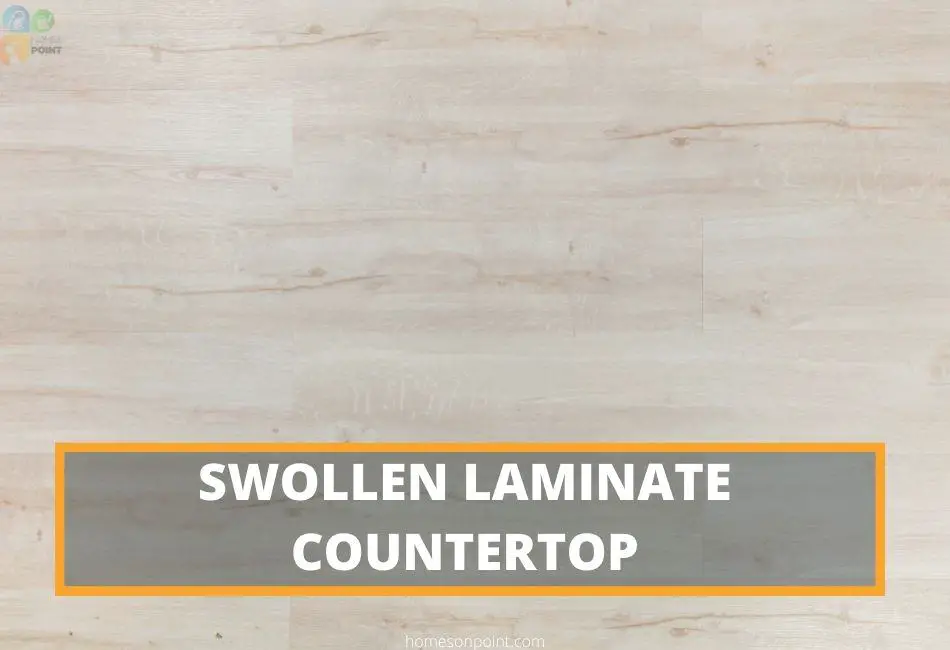You wake up one morning, enter the kitchen to make yourself a hot cup of coffee, and then notice something strange. Your laminate countertop appears to be swollen in places. You can’t help but wonder: why is my laminate countertop swollen? And more importantly, how do you fix it? This article will discuss the possible causes of a swollen laminate countertop and some solutions to fix it.
The most obvious reason your laminate countertop is swollen is because of water. When water seeps into the laminate, it causes the laminate to swell. It enters the laminate through the seams, edges, or other openings. Once the water is in the laminate, it can’t get out and the laminate will continue to swell.
Unfortunately, this happens to many homeowners who have installed laminate countertops. It’s important to remember that laminate is not waterproof. While it is resistant to water, it’s not impervious to it.
What Causes Laminate Countertop To Swell?
When laminate countertops begin to swell out of the blue, then you should know certain conditions are causing it. The top line cause is when there is a change in temperature or humidity. If there’s been a sudden change in either of these, it can cause the laminate to expand or contract, which can lead to swelling. Let’s look at some of the causes in more detail.
1. Leaky pipes
If you have laminate countertops, it’s important to check your pipes regularly. Major leaks are easy to find a fix but If there’s a slow leak, you may not notice it right away. Water will be seeping into the laminate and over time, the accumulated water will cause the laminate to swell.
If you also noticed a leak but decided to ignore it because it wasn’t major, you are doing your laminate countertop a disservice. The laminate will continue to swell until it’s fixed and the damage will be irreversible.
2. Leaky sinks and faucets
Another cause of laminate countertop swelling is due to leaking sinks and faucets. If your sink or faucet is leaking, water will be constantly dripping onto the laminate. Just like with a slow leak, the laminate will absorb the water and swell over time.
Sinks and faucets can leak for several reasons. It could be a loose washer, O-ring, or gasket. It could also be that the valves need to be replaced. Whatever the reason, it’s important to fix the leak as soon as possible to prevent further damage.
3. Allowing a pool of water to sit on the laminate countertop for long periods
Another cause of laminate countertop swelling is when you leave a pool of water to sit on the laminate for long periods. This could be from washing dishes or even just leaving a wet towel on the laminate. This may not cause the laminate to swell at the first instance but if it is a constant practice, the laminate will eventually start absorbing some of the water and swell over time.
When water sits on the laminate for too long, it has nowhere to go and will seep into the seams, edges, and any opening it can find.
4. Exposing laminate countertop to extreme heat
Laminate stick to the countertop using an adhesive. When laminate is exposed to extreme heat, the adhesive can soften and cause the laminate to lift. This is one of the reasons why placing hot pots directly from the stove onto the laminate is not recommended.
When the laminate starts to lift, it creates gaps and cracks. These gaps and cracks provide an opportunity for water to seep in and cause the laminate to swell.
5. Poor installation
If the laminate was not installed properly, it can also lead to swelling. This is because the laminate may not have been sealed properly, which can allow water to seep in and cause the laminate to swell. You can’t totally prevent water on your countertop that is why it is important that the laminate is sealed correctly to minimize the risk of water damage.
How To Prevent Laminate Countertop From Swelling?
Swollen laminate countertop is 100% preventable. By following a simple laminate countertop care guide, you can prevent this. The best way to prevent laminate countertops from swelling is by ensuring that there is no water damage. This can be done in several ways:
1. Fix leaks immediately
Check your pipes, sink, and faucet regularly for any leaks and fix them immediately. It’s important to not ignore any leaks, no matter how small, as they can cause laminate swelling over time.
Also, make sure your sinks and faucets are not leaking by checking the washers, O-rings, gaskets, and valves regularly. Consult a professional plumber if you are unsure how to do this.
2. Wipe spills immediately
One of the best ways to prevent laminate countertop swelling is by ensuring that there is no water accumulation on the surface. Do not leave a pool of water on the laminate for long periods. Use a paper towel or a clean cloth to wipe up any spills immediately. This will ensure the laminate is dry and prevent any water damage.
If you are washing dishes, make sure to use a dish rack and do not leave wet dishes on the laminate. Some dish racks have a drip tray that can catch any water that may fall from the dishes.
3. Do not leave wet towels on laminate countertop
Do not leave wet towels or any other wet objects on the laminate for long periods. You don’t want the laminate absorbing any water as this can cause the laminate to swell. Hang your wet towels on a towel rack or any other suitable place to dry other than the laminate countertop
4. Protect your laminate countertop from direct heat
Use a cutting board or a trivet when placing hot pots and pans on the laminate. Do not put anything directly from the stove onto the laminate as this can cause the laminate to lift. If you are also using any heat-emitting appliances, make sure there is a layer of protection between the countertop and the appliance.
There are many good heat-resistant countertop materials that can be used for this purpose so finding one should not be a problem.
5. Laminate should be properly sealed
If you are installing a laminate countertop, make sure it is properly sealed. This will ensure that water does not seep in and cause the laminate to swell. If you have used your laminate countertop for many years, you have to consider having it resealed to ensure it is still effective in preventing water damage.
How To Fix A Swollen Laminate Countertop
If your laminate countertop has started swelling, it’s important to fix it as soon as possible to prevent further damage. Since the damage is mostly caused by moisture, it is important to ensure that the laminate is dry before you start fixing it.
Here’s a quick fix for a small area of the laminate that is swollen:
What You’ll Need:
- Hair dryer or heat gun
- Putty knife
- Contact adhesive
- Flat weight or books
- Rolling pin
Procedure:
Step 1
The first thing you need to do is to find the source of the moisture and fix it. This can be done by checking for any leaks in the pipes, sink, and faucet. Once you have fixed the leaks, you can move on to the next step.
Step 2
Begin by lifting the laminate using a putty knife. Be careful not to damage the laminate as you lift it. Laminate is brittle and therefore easy to break or crack. Don’t lift one side too high as this can cause the laminate to crack. Lift gently and slowly until you can see the swollen area.
Step 3
Remove any debris or dirt that may be stuck in between the laminate and the substrate. This can be done using a putty knife. This will ensure that the laminate is clean and ready for the next step.
Step 4
Apply heat to the swollen area using a hair dryer or heat gun. The heat will help to dry out the laminate and make it more pliable.
You’ll also need to apply heat to the underside of the laminate if there is water damage. This will dry out any moisture that may have seeped in and make it tacky so that the laminate will adhere better when you put it back in place.
Step 5
Apply a layer of contact adhesive to both the laminate and the substrate. Wait for the adhesive to become tacky before you place the laminate back in place. Make sure that the laminate is properly aligned before you adhere it back in place.
Step 6
Use a rolling pin to flatten the laminate and remove any air bubbles that may have formed. Then, use a flat weight or books to press the laminate in place and allow the adhesive to dry.
Your laminate countertop should now be as good as new.
If the laminate is severely damaged, you may need to replace it entirely. If you have major damage, you may need to call in a professional to help you with the repair or replacement.
Final Words
Prevention Is The Best Solution.
It is always better to prevent the laminate from swelling in the first place. This can be done by following the tips listed above. By taking the necessary precautions, you can avoid having to deal with a swollen laminate countertop. I hope you found this useful. Thanks for reading.

